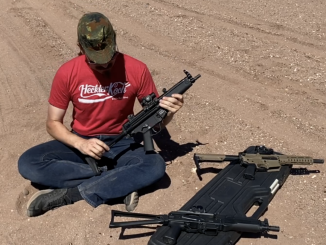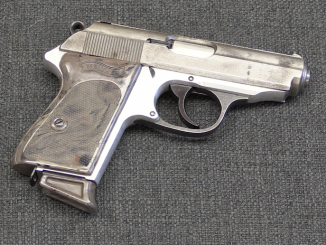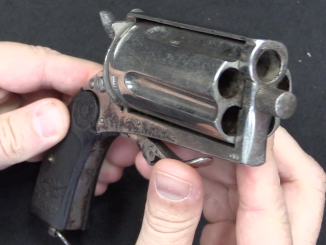https://youtu.be/ZJYPsUboKOI
Patented in Germany as System Schätzle, the L26 was a departure from the copies of the Russian wipe-based silencer designs. The L26 used a set of six identical cone-shaped metal baffles inside a simple tube. It attached to a rifle by clamping around the front sight, just like the rifle grenade launcher developed for the K98k.
The basic design was used for several different models; basically everything in the Wehrmacht arsenal that was 8mm in diameter (although not the antitank rifle…). This example is for rifles, but a model was also made for the MG42, and about 200 of them were actually fielded. Total rifle pattern production was supposed to be 1000 units, but manufacturing problems led to production ending early (we don’t know exactly how early).




Hard to imagine what would break on these. The design is so simple. Maybe the cones could not take the heat and pressure. It would be interesting for someone to make this design, using modern material.
“(…)model was also made for the MG42(…)”
Wait… MG42 does belong to recoil operated, so to my understanding sticking additional mass to barrel would affect its functioning. Were MG42 which were supposed to be host of L26 somewhat altered to work with it, if yes how and could they work reliable without it?
Also https://modernfirearms.net/en/machineguns/germany-machineguns/mg-42-i-mg-3-eng/ claims that feature of MG42 is
muzzle booster
is not that mutually exclusive with having suppressor, if not please provide example of any other fire-arm time which do sported muzzle booster and suppressor at same time.
I would expect the suppressor would have a similar effect on operation as the muzzle booster, as I rather suspect the muzzle booster is essentially a single baffle suppressor, much like today’s Flaming Pig or “Krink” muzzle device, adding additional back pressure to the mechanism.
I’m still ambivalent on the value of these things. For one, the “silencer” bit is mostly fantasy… By rights, they ought to be termed “moderators” or “mufflers”, because they’re not “Hollywood silent” in real life, unless they also manage the feat of doing away with the sonic boom of the projectile. The most you’re really going to accomplish is causing some confusion in the enemy about where you’re firing from, in almost all cases. And, frankly… That’s of questionable value.
The other thing is this: The psychology of it all. Loud noises are good when you’re the one making them, and bad when it’s the enemy. So, if you attenuate the noise, there goes the positive effect you get from firing your weapons, and the impact that noise has on the enemy.
The hearing protection argument is really the only thing that makes sense for me, and that’s only in limited training environments.
The one thing I’m going to say is that I think we’ve been missing a huge aspect of the issue, when it comes to weapons signatures. I can’t think of anywhere that we’ve really tried to do anything about actually using signatures alone; I think it’d be useful to be able to have the ability to create at least the sonic signatures of weapons to use intentionally in combat, if only to mask and/or confuse the enemy about what you’re actually doing. Say you had a “firefight in a box” that you could deploy during your assault on an objective, something that would make the defenders think they were being attacked somewhere else while your real assault was going in… If nothing else, that’d create confusion. Ideally, it’d cause the enemy to split their defensive response to waste effort defending against the fake fires source rather than your actual troops. We did this in a limited fashion during D-Day with the fake airborne dummies that had firecrackers integrated into them, but I don’t think we thought that through all the way or did everything we could with it.
As combat grows more complex, I think that there will be a place for this sort of thing. Imagine unmanned ground vehicles that could “fake the funk” well enough to mimic actual attacks, used as decoy operations while your real efforts were being conducted somewhere else. There will eventually be so many interlocking things going on in a fully-modern combat action that you’ll have to have full-time network management just to keep track of what’s really going on, because just sticking your head out and looking around is going to be useless with all the fakery and decoys that will be integrated into routine operations.
“(…)they ought to be termed “moderators” or “mufflers”(…)”
Schalldämpfer is name used for both muzzle device of weapon and part of motorcycle
https://de.wikipedia.org/wiki/Schalld%C3%A4mpfer
“(…)if you attenuate the noise, there goes the positive effect you get from firing your weapons(…)”
Whilst Deutsch name suggest sound reduction, such device should also lessen flash size, which should be useful if you are planning action before nautical twilight in morning or after nautical twilight in evening.
“(…)sonic signatures of weapons to use intentionally in combat(…)”
Soviet military during Cold War get similar effect although unintentionally.
Look at ПМП https://weaponland.ru/publ/vystrel_iz_pod_zemli_predelno_prosto_i_chrezvychajno_opasno/20-1-0-399
it is landmine, which does fire pistol cartridge, after someone stand at it.
It can be used in various environments, is reliable and relatively safe for planter, however it did not find widespread use, because it does not impose fear.
When enemy personnel activate it, most common reaction is “we are under fire” rather than “halt and summon mine flail” therefore does not halt/slow down as mines with explosives do.
The strange thing about a lot of weapons designers is that they very often either ignore or misattribute the psychological effect of their weapons. It’s like a lot of them have never actually met people, or something…
I blame the fact that a lot of designers are also from the categories of people that rarely, if ever, wind up going into combat. It’s hard to wrap your head around the fears and behaviors of people you’ve likely never met, doing things you’ve never had to do.
Victory or defeat in combat is an event that occurs primarily in the brains of the participants. This being a psychological thing, it’s a mistake not to include psychological factors in your calculations about weapons.
The point of weapons isn’t necessarily the killing of the enemy; sometimes, it’s way more effective to simply engender enough dread in them that they don’t want to go up against you. You’re seeking “Don’t do that, any more…”, not necessarily just “Dead”. There is a qualitative difference with regard to this between a weapons system that functions merely as a “death ray”, versus one that leaves entrails draped on every de-leafed tree in the forest…
Frankly, if you were to somehow capture the things that the “combatant classes” know instinctively, there’s a lot of things in weapons design that would get changed.
I further suspect that the “excessively high rate of fire” that we all lay at the door of “Error!” when discussing the MG34/42 weapons system came directly out of personal experience of the guys doing the laying-down of the design features they were looking for; if you’ve ever been under fire from an MG42, that’s something you’ll never, ever forget. It’s also something you won’t go seeking out opportunities to undergo again, either.
Were you to design weapons from this sort of standpoint, there’d be a lot more “BANG!!!!” and a lot less “pew-pew-pew”.
Although, psychological effects can be overcome. Dead? Not so much…
The matter of signature reduction has more to do with environment than psychology. I’ve always suspected that the L26 was intended for use with one or more of the IR “night sights” the Wehrmacht developed for “sniping”. At night, it would function both to reduce sound and to virtually eliminate muzzle flash, the latter mainly to avoid flaring the IR sight. And of course to avoid giving away the sniper’s position, especially at night.
Such a combination would have helped to economize on the number of snipers lost on the Eastern front to the usual Russian Army response to German sniping; artillery.
No, Enemy at the Gates to the contrary, the Wehrmacht had no real “sniper school” and not that many soldiers who had become effective snipers by “makee-learnee”. As was usual with the Wehrmacht, special equipment was conceived to make up for lack of actual learned skill. The German fascination with “Wunderwaffe” extended to more than just A4 ballistic missiles.
The L26 would have been a reasonable addition to any weapon fitted with the Zielgerat 1229 IR sight system, which was designed for the StG44 rifle as well as the MG34 and MG42 GPMGs.
https://en.wikipedia.org/wiki/Zielger%C3%A4t_1229
cheers
eon
“(…)Wehrmacht had no real “sniper school” and not that many soldiers who had become effective snipers by “makee-learnee”(…)”
Interestingly one of most famous sniper of III Reich active at Ostfront, Hetzenauer, was initially assigned to… mortar training, even despite he was former hunter. His mastery of rifle-using and thus his role changed.
For more data see https://allthatsinteresting.com/matthaus-hetzenauer
I’d love to be able to verify this with a citation or two, but one of the things I saw in that cache of German machinegun documentation I always go on and on about was a mention that someone had done a cost/benefit analysis of the WWI sniper effort on the German and Austrian side of it all, and they’d decided that snipers weren’t really all that effective for the amount of training and effort expended. The writer in that bit was arguing that it made a lot more sense to have a machinegun in that role, because there was no point to simply shooting one guy in the grand scheme of things. If it was worth hitting with a sniper, then it was worth hitting with a burst or two of fully-automatic fire, and killing everyone around the individual…
This mentality might have colored their thinking, and explain the lack of a formal sniper program above unit level. They obviously went to the trouble of issuing telescopic sights and other “sniper-like” tools, but… The reason they didn’t go further and establish a formal school above unit levels might be because they didn’t think it was worth the effort. I’ve heard people describe the German sniper effort as being primarily focused on what we’d call the “Designated Marksman” level of sniping, and I think that’s mostly correct.
“(…)citation(…)”
https://de.wikipedia.org/wiki/Matth%C3%A4us_Hetzenauer does claims that
…er vom 27. März 1943 bis zum 1. Juli 1943 erst die Ausbildung als mittlerer Granatwerfer-Schütze der Gebirgsjäger.
which is based on
Franz Thomas und Günter Wegmann (Hrsg.): Die Ritterkreuzträger der Deutschen Wehrmacht 1939–1945 – Teil IV: Die Gebirgstruppe. Band 2: L-Z, Biblio Verlag 1994, ISBN 3-7648-2430-1; S. 305ff.
Ah, Daweo… I meant the citation for that bit of apocrypha I was relating in reference to the German doctrinal decision not to emphasize a sniper program.
Every single time I run into something I remember from that cache, the more I kick myself in the ass for not keeping in touch with the guy who had it. There had to have been at least two file cabinets of stuff he had and was working with for a book I’ve never seen published. It’s all probably in a landfill, somewhere in Northern Illinois after his kids tossed it when he died. Huge loss, I think–He had stuff I’ve never seen anywhere else.
Which, frustratingly, I can’t now cite or use to prove any of my ravings about German machinegunnery.
Russian Army sniper doctrine was summed up by a quotation from their manual that was translated by Maj. John Plaster;
While remaining unseen, I observe and destroy.
Russian snipers were what we would call today “scout snipers”. Their primary mission was to observe the enemy’s movements and activities and report them.
Actual sniping was an “opportunity-based” part of the mission; if they saw a target of reasonable value, such as a German officer of Colonel rank or higher, and they could kill him without unnecessary risk of their own destruction, they’d do it.
But that was secondary to getting back to a forward CP to relay the position of a German company or etc. to the artillery and let the “Queen of Battle” take it from there.
Reading about this, I was reminded of the famous (if apocryphal?) list of Robert Rogers’ standing orders for the 75th Rangers;
4. Tell the truth about what you see and what you do. There is an army depending on us for correct information. You can lie all you please when you tell other folks about the Rangers, but don’t never lie to a Ranger or officer.
5. Don’t never take a chance you don’t have to.
I believe Rogers and the Russian Army’s snipers would have understood each other perfectly.
cheers
eon
Alas, I cannot find my notes regarding the demonstrations of newly developed equipment before Hitler, organized by Speer (erroneously called “Führerprotokolle” in German literature) .
But I am quite sure that numbers like L26 referred to a specific type of “Schalldämpfer” (at the time the cover name was “Haube” or hood). Any version for K98k, machine guns or assault rifle would have a different L-number not the same L26. Apart from that, several inventor designs (one name was Schneider-Opel) were assigned different numbers.
It looks like more research into this matter is necessary.
Wow, censoring the nazi flag. Never would have thought a historical site would do that.
If we keep such hidden in the closet, our grandchildren will know the horror it represented.
And guess what- I’m half jewish. Dont Censor History. Ever. Let the truth be known.
I do that because if I don’t, YouTube deletes it. Please direct your complaints to them, not me.
I suspect that their, let call high sensitivity for content with Hakenkreuz is due to Verbotsgesetz 1947 which does ban Hakenkreuz and other NSDAP-related things like their propaganda and Horst-Wessel-Lied and for breaking said rule does provide from 1 to 10 years of prison. For more details see https://anwalt-hofer.at/verbotsgesetz-1947-hohe-strafen-drohen/
‘NOT’ know the horror. sorry bout that.